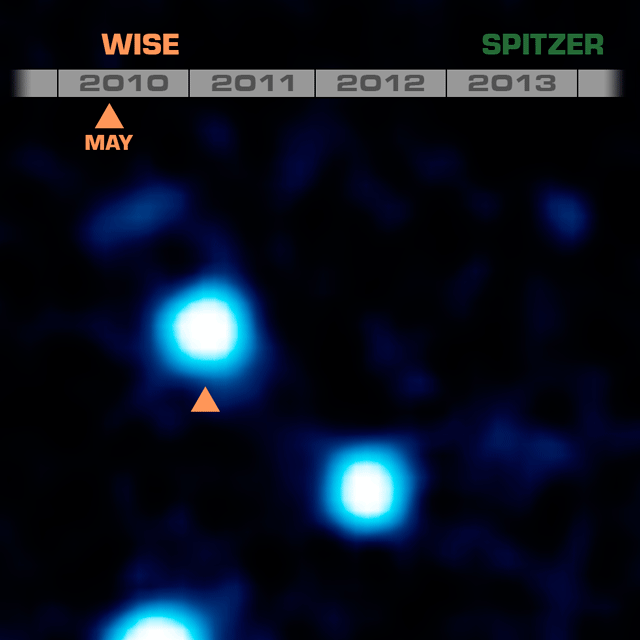NASA discovers the sun has an icy neighbor
Penn State University


NASA's Wide-field Infrared Survey Explorer (WISE) and Spitzer Space Telescope have found what appears to be a brown dwarf, or star-like object, that is as cold as the North Pole, just 7.2 light-years away from the sun.
The closest solar system to the sun is Alpha Centauri, about 4 light-years away.
"It is very exciting to discover a new neighbor of our solar system that is so close," Kevin Luhman, an astronomer at Pennsylvania State University's Center for Exoplanets and Habitable Worlds, said in a statement. "And given its extreme temperature, it should tell us a lot about the atmosphere of planets, which often have similarly cold temperatures."
The Week
Escape your echo chamber. Get the facts behind the news, plus analysis from multiple perspectives.

Sign up for The Week's Free Newsletters
From our morning news briefing to a weekly Good News Newsletter, get the best of The Week delivered directly to your inbox.
From our morning news briefing to a weekly Good News Newsletter, get the best of The Week delivered directly to your inbox.
Brown dwarfs begin as collapsing balls of gas, just like any other star, but they do not have enough mass to sustain nuclear fusion. This new brown dwarf — named WISE J085510.83-071442.5 — was found after WISE surveyed the entire sky at least twice using infrared light (NASA says that cooler objects stand out in infrared light because it captures their thermal glow). It is between -54 and 9 degrees Fahrenheit, which is much colder than the other brown dwarfs discovered by WISE and Spitzer, thought to be around room temperature.
"It is remarkable that even after many decades of studying the sky, we still do not have a complete inventory of the sun's nearest neighbors," Michael Werner, Spitzer's project scientist at the Jet Propulsion Lab, said in a statement. "This exciting new result demonstrates the power of exploring the universe using new tools, such as the infrared eyes of WISE and Spitzer." The animation below, courtesy of NASA/JPL-Caltech/Penn State, shows how the brown dwarf was spotted, thanks to its rapid motion across the sky. --Catherine Garcia

A free daily email with the biggest news stories of the day – and the best features from TheWeek.com
Catherine Garcia has worked as a senior writer at The Week since 2014. Her writing and reporting have appeared in Entertainment Weekly, The New York Times, Wirecutter, NBC News and "The Book of Jezebel," among others. She's a graduate of the University of Redlands and the Columbia University Graduate School of Journalism.
-
 6 lovely barn homes
6 lovely barn homesFeature Featuring a New Jersey homestead on 63 acres and California property with a silo watchtower
-
 Film reviews: ‘Marty Supreme’ and ‘Is This Thing On?’
Film reviews: ‘Marty Supreme’ and ‘Is This Thing On?’Feature A born grifter chases his table tennis dreams and a dad turns to stand-up to fight off heartbreak
-
 Political cartoons for December 14
Political cartoons for December 14Cartoons Sunday's political cartoons include a new White House flag, Venezuela negotiations, and more
-
 Blue Origin launches Mars probes in NASA debut
Blue Origin launches Mars probes in NASA debutSpeed Read The New Glenn rocket is carrying small twin spacecraft toward Mars as part of NASA’s Escapade mission
-
 Dinosaurs were thriving before asteroid, study finds
Dinosaurs were thriving before asteroid, study findsSpeed Read The dinosaurs would not have gone extinct if not for the asteroid
-
 SpaceX breaks Starship losing streak in 10th test
SpaceX breaks Starship losing streak in 10th testspeed read The Starship rocket's test flight was largely successful, deploying eight dummy satellites during its hour in space
-
 Rabbits with 'horns' sighted across Colorado
Rabbits with 'horns' sighted across Coloradospeed read These creatures are infected with the 'mostly harmless' Shope papilloma virus
-
 Lithium shows promise in Alzheimer's study
Lithium shows promise in Alzheimer's studySpeed Read Potential new treatments could use small amounts of the common metal
-
 Scientists discover cause of massive sea star die-off
Scientists discover cause of massive sea star die-offSpeed Read A bacteria related to cholera has been found responsible for the deaths of more than 5 billion sea stars
-
 'Thriving' ecosystem found 30,000 feet undersea
'Thriving' ecosystem found 30,000 feet underseaSpeed Read Researchers discovered communities of creatures living in frigid, pitch-black waters under high pressure
-
 New York plans first nuclear plant in 36 years
New York plans first nuclear plant in 36 yearsSpeed Read The plant, to be constructed somewhere in upstate New York, will produce enough energy to power a million homes
